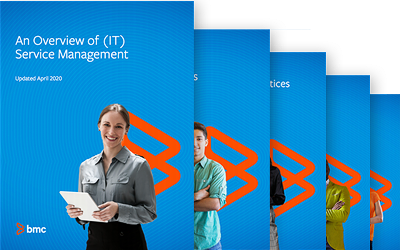ITIL® and PRINCE2® are two examples of technology guidance that is relevant in the digital age. Both approaches have been instrumental in the worlds of ITSM and project management for many years. Both have also been recently updated to evolve with modern ways of working.
Between ITIL and PRINCE2, which one is relevant for your organization? Here, we’ll look at the key differences between the ITIL and PRINCE2.
Download Now: ITIL 4 Best Practice e-Books
These all-new for 2020 ITIL e-books highlight important elements of ITIL 4 best practices. Quickly understand key changes and actionable concepts, written by ITIL 4 contributors.
ITIL vs PRINCE2
This graphic compares ITIL and PRINCE2. Below, we’ll summarize each aspect.

What is ITIL?
ITIL is an IT service management approach that focuses on end-to-end product and service management, from demand to value. It can be adopted and adapted to any organization that uses technology in service delivery. ITIL has evolved over the years, with ITIL 4’s most recent version released in 2019.
The name ITIL comes from its original inception as the Information Technology Infrastructure Library, which published methodology for IT infrastructure. Today, the acronym is no longer used and ITIL is simply the brand name. ITIL is owned and certified by Axelos.
Who uses ITIL?
The breadth and context of ITIL is significant in terms of business and technology aspects in service management—so anyone involved in industry sectors that use IT can learn and apply ITIL methodology. As the mainstay of ITIL is IT service management, staff working in IT are the primary target.
Core components of ITIL
The two main components of ITIL are the Service Value System (SVS) and Four Dimensions model.
The SVS represents how the various components and activities of the organization work together to facilitate value creation through IT-enabled services. It includes:
- ITIL service value chain
- ITIL management practices
- ITIL guiding principles
- Governance
- Continual improvement
The Four Dimensions model outlines the four components that your company’s SVS must consider to be holistic and balanced in its approach:
- Organizations and people
- Information and technology
- Partners and suppliers
- Value streams and processes
Exceptions: What ITIL isn’t
ITIL 4 does not specifically exclude any topics or components related to service management, though detailed discussion on specific technology use is not part of the guidance.
ITIL certifications
Currently, the main certification course modules in ITIL 4 are:
- ITIL Foundation
- ITIL Managing Professional Stream
- ITIL Specialist Create, Deliver & Support
- ITIL Specialist Drive Stakeholder Value
- ITIL Specialist High Velocity IT
- ITIL Strategist Direct, Plan & Improve
- ITIL Managing Professional Transition
- ITIL Strategic Leader Stream
- ITIL Strategist Direct, Plan & Improve
- ITIL Leader Digital & IT Strategy
- ITIL Master
What is PRINCE2?
PRINCE2 is a structured project management method that can be applied to any industry because it is intentionally generic. It separates management from specialist work and focuses on the ‘what’ rather than the ‘how’ of management.
The name PRINCE is an acronym for Projects IN Controlled Environments. The original definition has remained the same, and the “2” refers to the revision carried out in 1996. Subsequent version updates in 2009 and 2017 did not change the number, so PRINCE2 remains the brand name. Like ITIL, Axelos also owns and certifies PRINCE2.
Who uses PRINCE2?
PRINCE2 is useful for anyone involved in projects be it executive leadership or staff handling any aspect of a project within an organization. However, the primary target is usually project managers and anyone working in a project management office.
Core components of PRINCE2
PRINCE2 methodology consists of four integrated elements:
- Principles. Seven guiding obligations and good practices which determine whether a project is genuinely being managed using PRINCE2.
- Themes. Seven aspects of project management that must be addressed continually and in parallel throughout the project.
- Processes. Seven series of actions describing the progression of the project lifecycle, from start to closure. Each process has checklists of recommended activities, products, and related responsibilities.
- Environment. Guidance on tailoring PRINCE2 to create your organization’s own project management method and embedding it into your culture’s way of working.
Exceptions: What PRINCE2 isn’t
PRINCE2 considers three topics outside its scope of project management methodology:
- Specialist aspects
- Detailed techniques
- Leadership capability
If these are your priorities, PRINCE2 may not be the framework for you.
PRINCE2 certifications
Currently, the main certification course modules in PRINCE2 are:
- PRINCE2 Foundation
- PRINCE2 Practitioner
- PRINCE2 Agile Foundation
- PRINCE2 Agile Practitioner
Choosing between ITIL and PRINCE2
Whether an organization is looking to implement projects to digitally transform their operations or simply to align their service management approach to meet the needs of the digital landscape, it is clear that ITIL and PRINCE2 can support and provide value for both goals.
Though the two may seem unrelated, companies have successfully adapted ITIL and PRINCE2 in tandem to support both IT and overall business goals.
Additional resources
For more information on incident, problem, and change management, browse our ITIL 4 Guide, with 20+ articles on ITIL. Ready for the only end-to-end ITSM and ITOM platform for your company? Explore BMC Helix.







